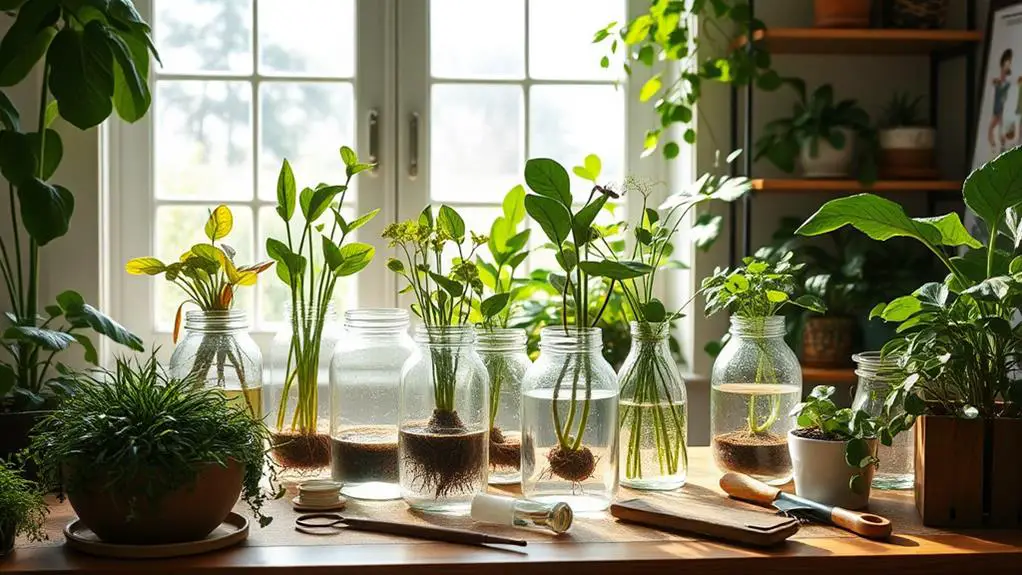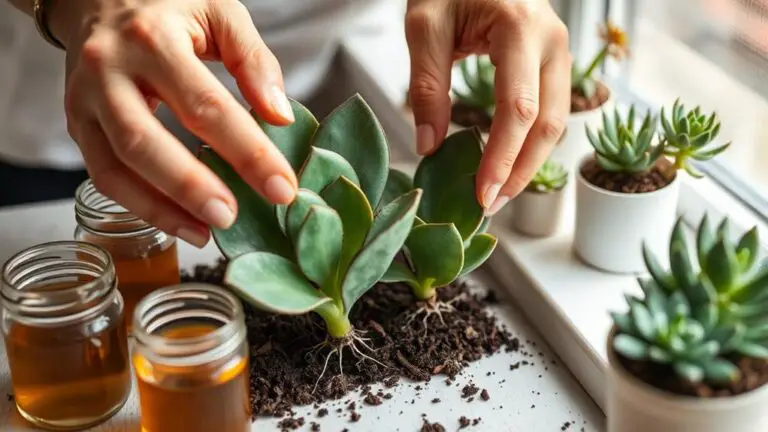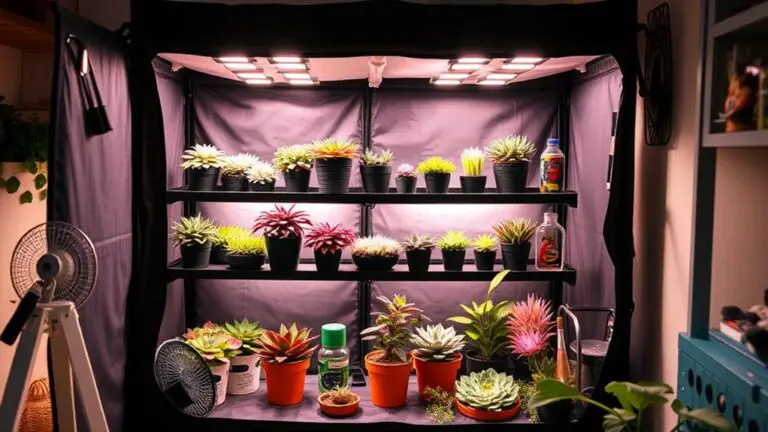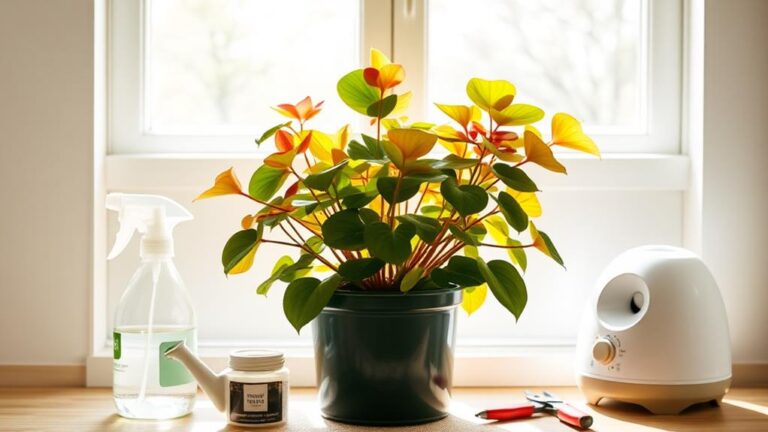Why Dry Propagation Is the Best Method for Beginners
When you're just starting with succulent gardening, dry propagation stands out as the most beginner-friendly method. It's simple and minimizes risks, particularly when it comes to preventing root rot and moisture-related diseases. By letting your cuttings callous before planting, you set the stage for successful root development without much hassle. All you need are some scissors and well-draining soil, making the process accessible and encouraging. But what exactly makes this method so effective, and how can you get started? Let's explore the key steps and benefits that make dry propagation ideal for novice gardeners.
What Is Dry Propagation?
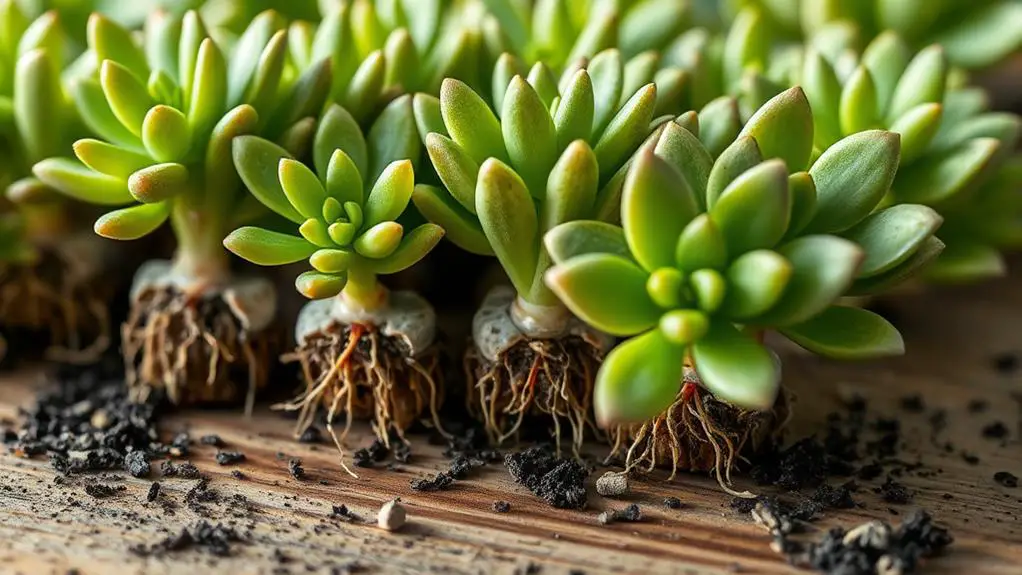
Dry propagation, also known as air propagation, is a method where you let succulent cuttings callous before planting. This technique is perfect for beginner gardeners looking to propagate succulents like Graptoveria and Echeveria. By allowing the cuttings to dry and form a callous, you greatly reduce the risk of root rot and other moisture-related diseases.
To start, gently remove healthy leaves or stem cuttings from the parent plant. Place these cuttings in a shaded area and let them dry for a few days. This drying period is essential as it helps form a protective layer over the cut, promoting healthier root development once planted.
The dry propagation method is especially beneficial for rosette succulents. These types of succulents are prone to root rot if exposed to too much moisture during propagation. By using air propagation, you're giving your succulent cuttings a better chance to develop strong, healthy roots.
This method doesn't require many materials, making it accessible for anyone. You're less likely to encounter moisture-related issues, which means a higher success rate for your new plants.
Dry propagation is a straightforward, effective way to propagate succulents and grow a healthy garden.
Benefits for Beginners
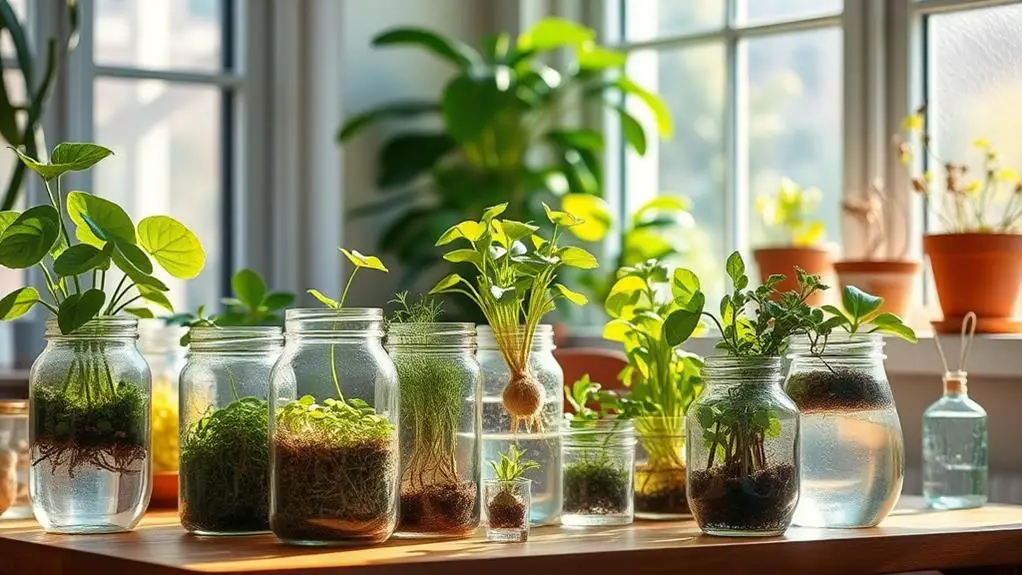
Dry propagation is perfect for beginners because it's simple and doesn't need many tools.
You'll find that this low-maintenance approach reduces the risk of rot, leading to higher success rates.
Plus, watching your cuttings grow roots will boost your confidence and encourage you to try new plants.
Simple, Low-Maintenance Approach
One of the greatest advantages of dry propagation for beginners is its simplicity and low-maintenance nature. You don't need much to get started—just a pair of scissors to remove leaves, making this method accessible even if you're new to gardening.
Dry propagation involves letting the cuttings callous over before they develop roots naturally in a dry environment, which reduces the risk of rot and encourages healthy growth.
Here's why dry propagation is perfect for beginners:
- Minimal tools required: All you need is a pair of scissors.
- Low-maintenance: No constant monitoring or watering needed.
- Encourages healthy growth: The callousing process helps prevent rot and allows roots to develop naturally.
- Accessible for beginners: Simple steps and fewer tools make it easy to start.
- Suitable for popular plants: Ideal for rosette succulents like Echeveria, which are known for their ease of care and beauty.
High Success Rates
Building on the simplicity and low-maintenance nature of dry propagation, another major advantage for beginners is its high success rate. This method lets your succulent cuttings callous before planting, which helps reduce the risk of rot and promotes healthy roots.
Because dry propagation eliminates excess moisture, you're less likely to face pest infestations like mealybugs, which often thrive in damp conditions.
For beginners, dry propagation is a game-changer. It's easier to maintain ideal moisture levels, so you don't have to worry about overwatering or underwatering. The process is simple and requires minimal effort—you just need basic materials and a bit of patience.
New roots usually develop within one to two months, giving you quick results and boosting your confidence in succulent care.
The high success rates associated with dry propagation mean you're more likely to see your efforts pay off. This can be incredibly encouraging when you're just starting out.
Plus, it's a great way to learn the basics of succulent care without feeling overwhelmed. With dry propagation, you're set up for success right from the start.
Materials Needed
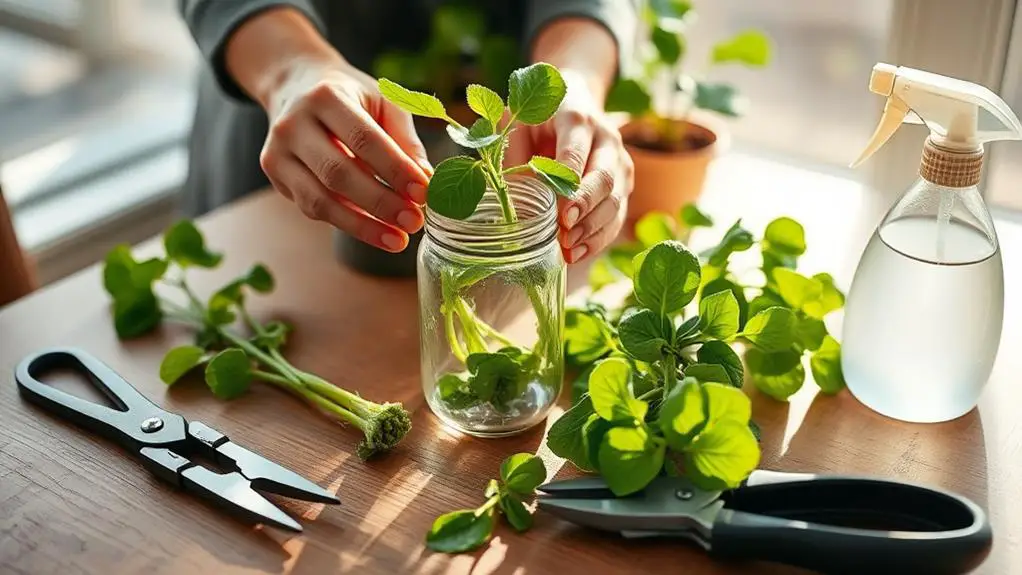
To get started with dry propagation, you'll need some basic materials: healthy succulent leaves, scissors, and a tray or dish for your cuttings.
It's a good idea to have well-draining soil on hand, and you might also want to use perlite or sand to improve drainage.
An optional moisture meter can help you keep track of soil moisture levels, ensuring your new plants don't get overwatered.
Essential Propagation Tools
When you're starting dry propagation, having the right tools is vital for success. To guarantee your succulent propagation goes smoothly, gather these specific tools and materials. They'll help you navigate the rooting process with ease and prevent common issues like rot.
- Clean scissors: Sharp, clean scissors are fundamental for making precise cuts on succulent leaves without damaging the plant.
- Tray or plate: Use a tray or plate to place your cut leaves in a shaded area. This helps them callous over without direct sunlight, which can dry them out.
- Well-draining soil: A cactus mix is perfect for when you transplant your rooted cuttings. It guarantees the soil doesn't hold too much moisture, supporting healthy root development.
- Moisture meter: This handy tool helps monitor soil moisture levels, so you don't overwater your cuttings once they're planted.
- Cinnamon: While optional, cinnamon can act as a natural antifungal treatment. Applying it to cut ends before planting can help prevent rot during the rooting process.
Using these vital tools and materials can make your propagation experience smoother and more enjoyable. You'll be well on your way to propagating succulents successfully!
Simple Household Items
Often, you'll find that dry propagation can be achieved with simple household items you already have on hand. This method is perfect for beginners because it requires minimal investment.
Start with healthy succulent leaves and a tray or egg carton to support them upright. These items help the leaves stay in place as they dry and roots grow.
You'll need a pair of clean, sharp scissors to gently remove leaves from the mother plant without causing damage. After you've cut the leaves, place them in a shaded area with indirect light to prevent moisture loss. This step is essential for successful dry propagation.
Once the leaves have dried, you'll want to use a well-draining soil mix when you eventually pot the rooted cuttings. This type of soil helps guarantee that your new succulents thrive.
If you have cinnamon at home, it can be used as an optional antifungal treatment to promote healthy root development.
Step-by-Step Process
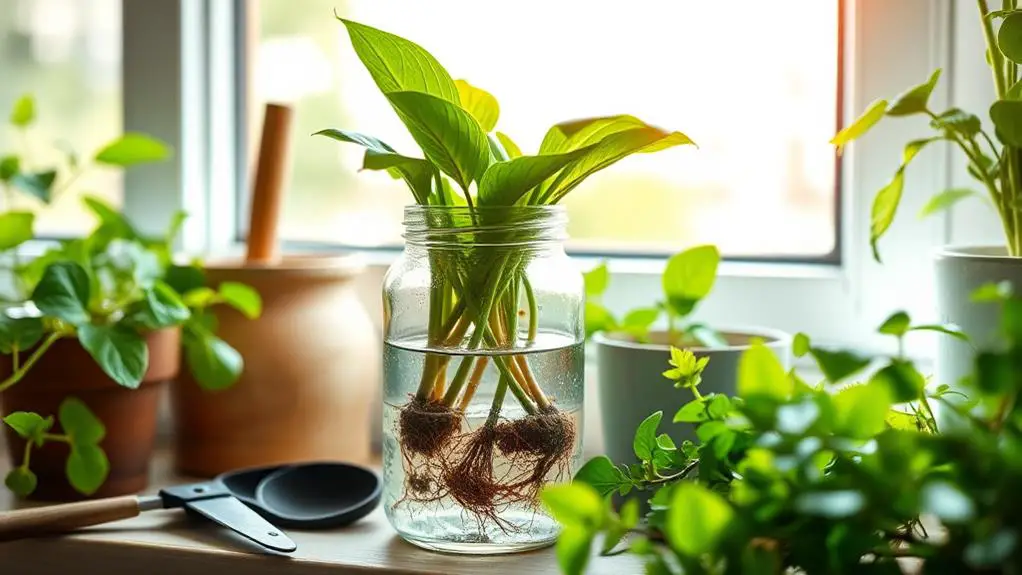
Kick off your dry propagation journey by thoroughly watering the parent succulent for three days, boosting the juiciness of the leaves. This step guarantees you have healthy leaves for propagation.
Next, gently twist and remove healthy, mature leaves from the mother plant, selecting only those that are thick and plump to maximize rooting potential.
Place the removed leaves on a tray in a cool, shaded area. Let them dry and callous for 1-3 days before planting to prevent rot.
After the callousing period, prepare a well-draining soil mix and insert the calloused ends of the leaves into the soil. Make sure they're stable but not buried too deep.
Here's a quick rundown of the step-by-step process:
- Water the parent succulent for three days.
- Remove healthy, thick, and plump leaves by gently twisting.
- Allow the leaves to callous for 1-3 days in a shaded area.
- Prepare well-draining soil and place the calloused ends into it.
- Lightly water and monitor for root development.
Monitor the leaves for root development over the next few weeks. Look for healthy roots that appear white or pink.
Be careful to avoid over-watering until roots are well-established. This step-by-step process will set you up for successful propagation!
Common Issues
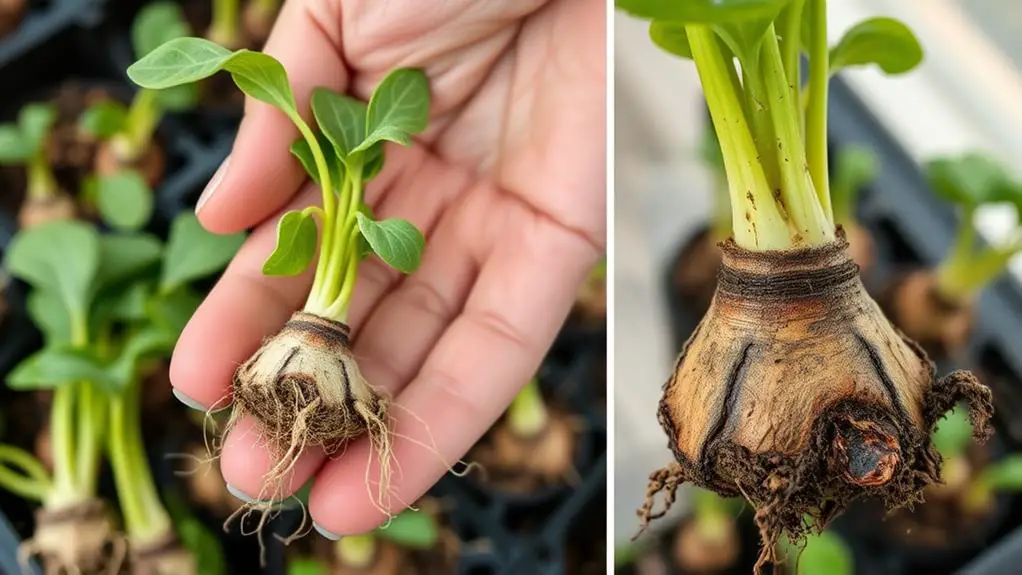
Although dry propagation can be a straightforward process, several common issues can arise and hinder your success. One of the most frequent problems is a lack of root growth, often due to poor environmental conditions like low humidity or improper light conditions. Another issue is overwatering before roots develop, which can lead to rot. So, it's essential to avoid watering until roots are fully established.
Selecting the wrong leaves for your cuttings is another common mistake. Always use mature, thick, and healthy leaves for the best chances of successful propagation. If your cuttings develop roots but no pups, it could be a sign that they didn't receive enough light during the rooting phase.
Stalling growth, where there's no visible progress after several weeks, may indicate the need for adjustments in humidity levels or light exposure. Here's a quick reference table for some common problems and their solutions:
| Common Problems | Solutions |
|---|---|
| Lack of root growth | Increase humidity, improve light |
| Overwatering | Wait until roots are fully established |
| Using unhealthy leaves | Use mature, thick, healthy leaves |
| No pup development | guarantee adequate light during rooting |
| Stalling growth | Adjust humidity and light exposure |
Lighting and Environment
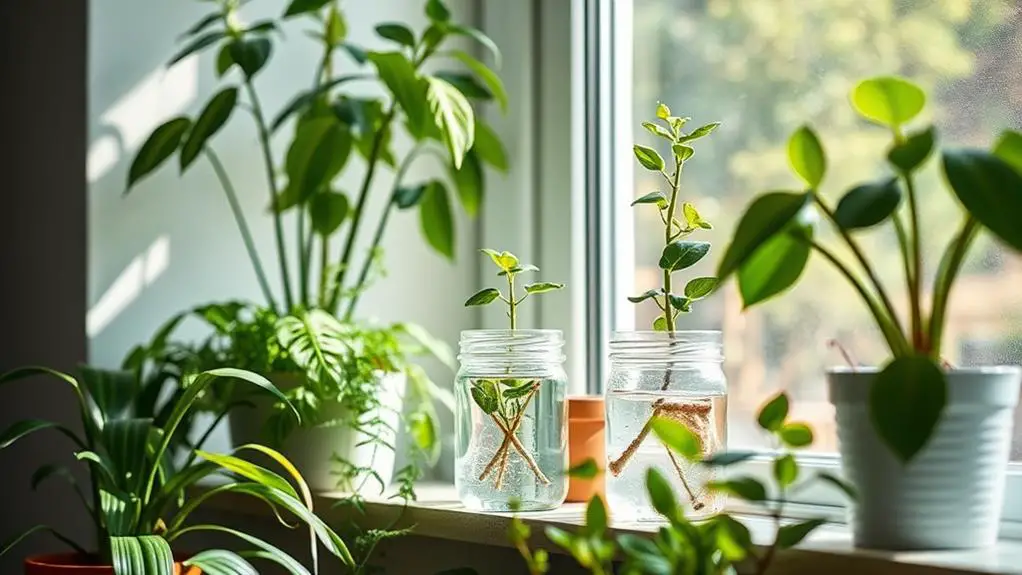
Bright indirect light is crucial for the successful dry propagation of succulents. It helps root development without risking leaf burn from direct sunlight. To guarantee your succulent cuttings thrive, follow these tips on lighting and environment.
- Bright indirect light: Place your succulents in a spot where they get plenty of light but not direct sunlight.
- Consistent light schedule: Keep the light schedule steady, ideally from 6 am to 10 pm, to help the cuttings grow strong roots.
- Warm environments: Make certain the temperature stays above 70°F (21°C) for the best growth. Warmth encourages healthy growth and prevents stalling.
- Propagation medium: Using egg cartons can be a great option. They help retain moisture while allowing for adequate airflow around the leaves.
- Adapt to seasonal changes: As seasons change, you might need to adjust your light sources. Grow lights can help maintain ideal conditions year-round.
Don't forget, succulents need the right conditions to thrive. By providing bright indirect light, maintaining a consistent light schedule, and guaranteeing a warm environment, you'll set your succulent cuttings up for success.
Keep an eye on seasonal changes and adjust as needed to ensure they get the light they need.
Recommended Soil and Care
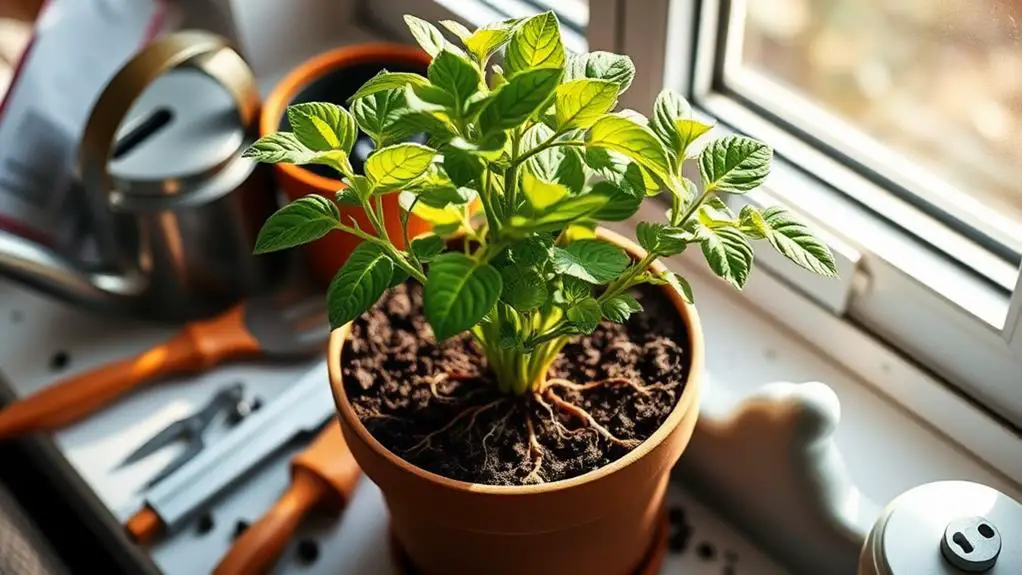
To guarantee your succulent cuttings flourish, start by selecting the right soil mix. Using an organic succulent and cactus soil mix, priced from $11.99, is vital for providing proper drainage and aeration. This supports healthy root development in propagated succulents.
When planting new cuttings, make sure they're placed in well-draining soil to prevent moisture retention that can lead to root rot. You can improve the texture and enhance drainage by adding perlite or sand to the soil mix. This makes it more suitable for succulent propagation.
After potting your new plant, wait three days before watering. This allows the roots to settle into the soil and adjust to their new environment. It's important to monitor soil moisture levels regularly.
Succulents thrive in dry conditions, and overwatering is a common issue for beginners. Well-draining soil is vital to avoid waterlogged roots. Remember, the goal is to keep your succulents healthy and their roots strong.
Being mindful of these simple steps will help you succeed in dry propagation. Feel confident knowing that with the right soil and care, your succulent cuttings will grow beautifully.
Frequently Asked Questions
What Is the Easiest Propagation Method?
You'll find dry propagation the easiest method. Simply let succulent leaves callous before planting to prevent rot. It needs minimal materials and guarantees stronger roots. Monitor root growth weekly without watering to avoid moisture issues.
What Method of Plant Propagation Is Best for You Why?
Dry propagation is best for you because it's simple and requires minimal tools. You let cuttings dry before planting, reducing rot risk. It's perfect for succulents like Echeveria, letting you easily monitor root growth and experiment with different species.
What Is Dry Propagation?
Dry propagation is a technique where you let succulent cuttings dry and callous before planting. This reduces the risk of root rot and diseases, making it a simple, effective method for growing healthy succulents.
What Is the Best Method of Propagation for Succulents?
Dry propagation's the best method for succulents. You minimize root rot risks and need only basic tools. Just let the cut leaves callous before planting. It's easy, effective, and great for beginners to monitor progress.
Conclusion
By choosing dry propagation, you're setting yourself up for success in succulent gardening. It's easy, low-risk, and requires minimal tools, making it perfect for beginners. You'll quickly see your cuttings develop roots, boosting your confidence. Just remember to let the cuttings callous, use well-draining soil, and provide the right lighting. With this method, you'll enjoy experimenting with different succulents and watch your garden thrive. Happy gardening!

